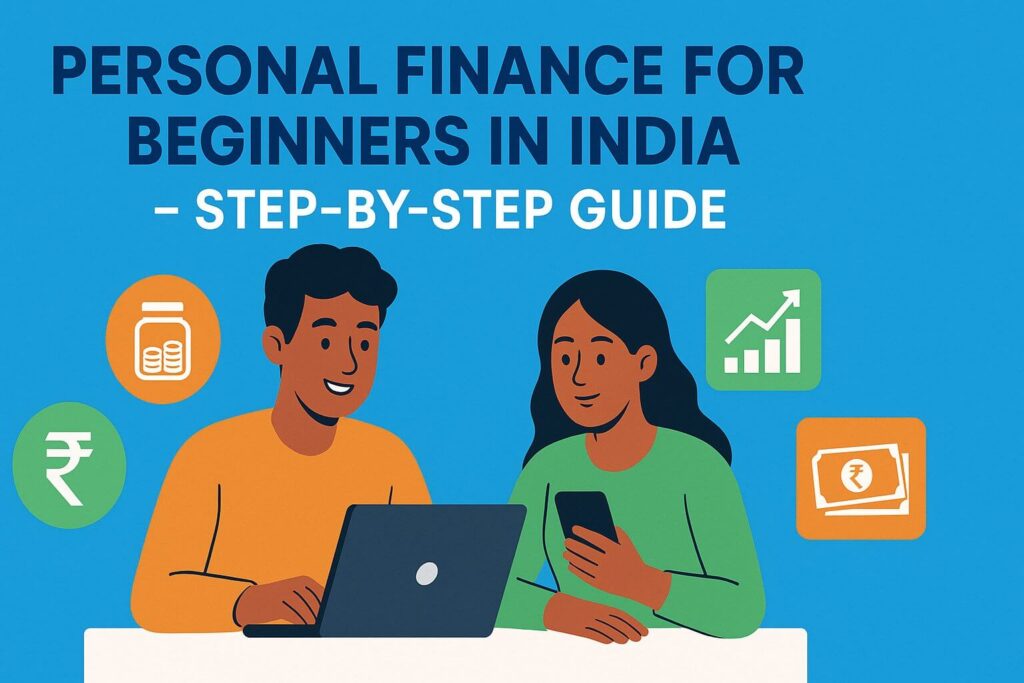Personal Finance for Beginners in India – Complete Step-by-Step Guide

Socho yaar – tumhari pehli job lag gayi hai Bangalore, Gurgaon ya Mumbai me. Salary account me aayi ₹30,000–₹50,000, aur mann me ek hi feeling – “Boss life shuru ho gayi!” 🚀
Pehle 10–15 din ekdum mast – Swiggy orders, weekend outings, Netflix, new clothes, shayad ek naya EMI wala iPhone bhi. Lekin jaise hi 25th aata hai… bank balance ekdum desert 🌵. Savings = ZERO.
Yehi situation India me har naye earning wale ko face karni padti hai. Aur yahin pe [Personal Finance for Beginners in India] ka role aata hai. School/college me kisi ne hume money management nahi sikhaya, lekin asli zindagi me ye hi skill sabse important hai.
Is blog me main tumhe ekdum step-by-step guide dunga – kaise apne paise ko manage, save aur grow karna hai bina boring finance lecture ke.
Kyun zaroori hai Personal Finance India me?
RBI ki ek survey ke according, sirf 27% Indians ko basic financial literacy hai. Matlab 70% logon ko budgeting, saving ya investing ke bare me basic bhi knowledge nahi hai.
Aur galtiyan costly hoti hain:
- Be-wajah loans lena.
- Emergency ke liye paisa na bachana.
- Credit card debt me fass jana.
- Investments ko ignore karna till it’s too late.
👉 Agar tum 18–35 ke beech ho, abhi best time hai control lene ka. Chhote steps aaj future me massive difference laa sakte hain.
Step 1: Samjho Basics of Personal Finance
Personal finance complicated nahi hai. Simple language me iska matlab hai:
- Earn → Salary, business, freelancing, side hustle.
- Spend → Rent, groceries, Swiggy/Zomato, EMIs, shopping.
- Save → Short-term aur long-term ke liye paisa bachaana.
- Invest → Paisa ko grow karna (mutual funds, stocks, PPF, gold).
- Protect → Insurance aur emergency fund se secure rehna.
💡 Example: Rahul, ek 25-year-old engineer Pune me, ₹45,000 salary kamata hai. Agar wo randomly kharch karega toh end me zero bachega. Lekin agar wo expenses, savings aur investments ka ek budget banata hai – toh wo lifestyle bhi enjoy karega aur wealth bhi build karega.
Step 2: Budgeting – Har ₹ ka ek kaam fix karo

Budget ke bina money vanish ho jata hai.
India me popular budgeting methods:
1. 50/30/20 Rule
- 50% → Needs (rent, food, travel, bills).
- 30% → Wants (shopping, movies, trips).
- 20% → Savings & investments.
2. Zero-Based Budgeting
- Har ek rupee ka ek kaam fix. Agar ₹40,000 earn karte ho, toh pura ₹40,000 allocate karo.
3. Envelope Method (desi style)
- Cash ya Paytm wallets me categories bana lo – “Food,” “Bills,” “Travel.”
💡 Example: Sneha, 22, Delhi me internship kar rahi hai aur stipend hai ₹12,000. Usne 50/30/20 rule lagaya – ₹6,000 needs, ₹3,600 lifestyle, aur ₹2,400 SIP. Student hote hue bhi wo investing habit bana rahi hai.
Step 3: Emergency Fund – Sabse pehle safety
Pehla financial goal iPhone kharidna nahi hona chahiye. Sabse pehle banao ek emergency fund.
👉 Rule: 3–6 months ke expenses ka paisa easily accessible jagah pe rakho.
Options:
- High-interest savings account (like IDFC, SBI Digital).
- Fixed Deposits.
- Liquid mutual funds.
💡 Example: COVID-19 ke time jin logon ke paas emergency savings thi unhone bina stress survive kiya. Jin ke paas nahi thi unko personal loan aur credit card pe depend karna pada.
Step 4: Debt ka game samjho
Debt lena galat nahi, lekin galat debt lene se finance barbaad ho jata hai.
Good Debt vs Bad Debt
- ✅ Good Debt: Education loan, home loan.
- ❌ Bad Debt: Credit card outstanding, BNPL misuse (Flipkart, Amazon Pay Later).
Debt se bachne ke tips
- Credit card dues pehle clear karo (interest 36% hota hai!).
- EMI delay mat karo, warna CIBIL score gir jaayega.
- Sirf utna hi borrow karo jitna easily repay kar sako.
💡 Example: Arjun ne ₹1 lakh ka iPhone credit card pe liya aur bill time pe clear nahi kiya. Interest lagte-lagte wo ₹1.2 lakh ho gaya. Neha ne wait kiya, save kiya aur cash me phone liya. Bas ek decision ne unka financial future change kar diya.
Step 5: Saving vs Investing
Mostly Indians sochte hain saving = paisa bank me daal dena. Lekin inflation (5–6%) ke chakkar me aapke 3% bank interest kaam nahi aata.
👉 Solution:
- Savings = short-term goals (trip, emergency, gadgets).
- Investing = long-term wealth (retirement, house, future plans).
Step 6: Investing for Beginners in India

Investing complicated lagta hai, but chill – ek roadmap hai.
Best beginner-friendly options:
1. Mutual Funds via SIP
- Start ₹500/month se.
- Equity mutual funds = growth.
- Debt funds = safer, short-term.
2. FDs
- Safe returns (5–7%).
3. PPF
- Government – backed PPF Scheme, 15 years, ~7% return + tax benefits.
4. Stocks
- Risky, shuruat me avoid karo.
5. Gold
- Digital gold, Sovereign Gold Bonds.
💡 Example: Agar tum ₹3,000 SIP mutual fund me 20 saal invest karte ho @12% return, tum ₹7.2 lakh invest karoge aur ~₹30 lakh ban jaayega. That’s compounding ka magic.
Step 7: Tax Planning – Paisa bachaana hi paisa kamaana hai
Boring lagta hai, but taxes save karoge toh wahi paisa extra investment ban jayega.
80C ke popular options (limit ₹1.5 lakh)
- PPF.
- ELSS mutual funds.
- EPF.
- Life insurance premiums.
💡 Example: Agar tumhara salary ₹7 lakh hai aur tumne ₹1.5 lakh ELSS me invest kiya, toh tum ~₹45,000 tax save kar loge. Ek extra month ki salary free samjho.
Step 8: Insurance – Pehle protection, phir growth
India me log insurance = investment samajh lete hain. Lekin asli insurance = protection.
Must-have insurance types:
- Health Insurance (min ₹5 lakh cover).
- Term Insurance (family ka safety net).
- Vehicle Insurance (mandatory + useful).
💡 Example: Ramesh ke surgery ka bill aaya ₹5 lakh. Health insurance ne cover kar diya. Uska dost jiske paas insurance nahi tha, usne borrow karke bill bhara.
Step 9: Extra Income Streams banao
Sirf ek salary par depend rehna risky hai.
Side income ideas:
- Freelancing (Upwork, Fiverr, Internshala).
- YouTube / Blogging.
- Digital products (eBooks, online courses).
- Dividend stocks, rental property.
Even ₹5,000–₹10,000 extra monthly = major boost.
Step 10: Money Mindset – Psychology samajho

Paise ka game sirf numbers ka nahi, soch ka bhi hota hai.
- Salary badhne pe kharch bhi mat badhao (lifestyle inflation).
- Insta lifestyle se compare karna chhodo.
- Long-term financial freedom pe focus karo.
💡 Example: Ankit (salary ₹80k) har month parties, gadgets me udaa deta hai. Priya (salary ₹50k) ₹15k invest karti hai. 10 saal baad Priya financially free hogi, Ankit paycheck-to-paycheck.
Common Money Mistakes Indians karte hain
❌ Sirf bank me saving.
❌ Emergency fund ignore karna.
❌ Credit card ka outstanding ignore karna.
❌ Insurance ko investment samajhna.
❌ “Abhi young hoon, baad me invest karunga” wali soch.
Conclusion – Personal Finance for Beginners in India
Agar tum yeh padh rahe ho toh congrats 🎉 – tumne pehla step le liya hai financial freedom ki taraf. Money management rocket science nahi hai. Bas thoda discipline aur consistency chahiye.
Quick action plan:
- Budget banao.
- Emergency fund ready rakho.
- Bad debt clear karo.
- ₹500 se SIP start karo.
- Health aur term insurance lo.
- Learning continue rakho.
Yaad rakho – [Personal Finance for Beginners in India] overnight rich hone ka shortcut nahi hai. Yeh ek long-term game hai jahan smart aur consistent decisions hi compound hoke wealth banate hain.
📢 Iss blog ko apne doston ke saath share karo .
Together grow karte hain! 💪
